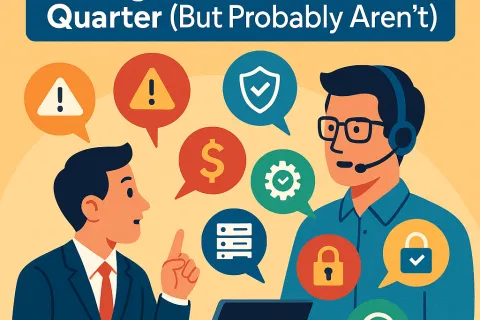March 24, 2025
Business e-mail compromise (BEC) is rapidly emerging as one of the most significant cyber threats facing businesses today. Although these scams have been a challenge for organizations for years, the rise of advanced AI tools has enhanced their sophistication and increased their danger.
In 2023, BEC scams led to $6.7 billion in global losses. Even more concerning, a study by Perception Point indicated a 42% rise in BEC incidents in the first half of 2024 compared to the same timeframe the previous year. As cybercriminals leverage AI to improve their methods, this trend is likely to continue.
What Are Business E-mail Compromise (BEC) Attacks?
BEC scams differ from typical phishing attempts. They are highly targeted cyberattacks in which criminals exploit email accounts to deceive employees, partners, or clients into disclosing sensitive information or transferring funds. Unlike generic phishing, BEC scams frequently involve impersonating trusted individuals or organizations, making them much more believable and effective.
Why Are BEC Attacks So Dangerous?
BEC scams are alarmingly effective because they exploit human trust rather than relying on malware or attachments, which can often be caught by filters. Here are the reasons they are so harmful:
They can lead to:
- Significant Financial Losses: A single convincing email can lead to unauthorized payments or data breaches. The average loss per attack exceeds $137,000, and recovering stolen funds is extremely difficult.
- Operational Disruption: An attack can halt business activities, resulting in downtime, audits, and internal disarray.
- Reputational Damage: How do you reassure clients that their sensitive information might have been compromised?
- Loss of Trust: Employees may feel less secure knowing their organization has been vulnerable.
Common BEC Scams To Watch Out For
BEC scams manifest in various forms. Here are some of the most prevalent:
- Fake Invoices: Cybercriminals impersonate vendors and send realistic invoices requesting payment.
- CEO Fraud: Hackers pose as executives, pressuring employees to transfer funds under tight deadlines.
- Compromised E-mail Accounts: Legitimate accounts are hacked and used to send harmful requests.
- Third-Party Vendor Impersonation: Trusted vendors are spoofed, making fraudulent requests seem routine.
How To Protect Your Business From BEC
The encouraging news is that BEC scams can be prevented with the right strategies:
Train Your Team Like It's Game Day
- Educate employees on identifying phishing emails, particularly those labeled "urgent."
- Require verbal confirmation for any financial requests.
Enforce Multifactor Authentication (MFA)
- MFA serves as a safety net, even if a password is compromised. Activate it on all accounts, especially email and financial platforms.
Test Your Backups
- Regularly restore data from backups to ensure they function correctly. A faulty backup during an attack could severely impact your business.
Get Serious About E-mail Security
- Utilize advanced email filters to block harmful links and attachments.
- Regularly audit access permissions and promptly revoke access for former employees.
Verify Financial Transactions
- Always confirm large payments or sensitive requests through a separate communication channel, such as a phone call.
Next Steps For Security
Cybercriminals are continually evolving, but you can stay ahead of them. By training your team, securing your systems, and verifying transactions, you can fortify your business against BEC scams.
Want to ensure your business is
protected? Start with a FREE 15-Minute Discovery Call to uncover vulnerabilities,
secure your systems and keep cybercriminals out.
Click here or give us a call at (336) 443-0061 to schedule your FREE
15-Minute Discovery Call today!
Let's stop BEC in its tracks - before
it stops your business.







